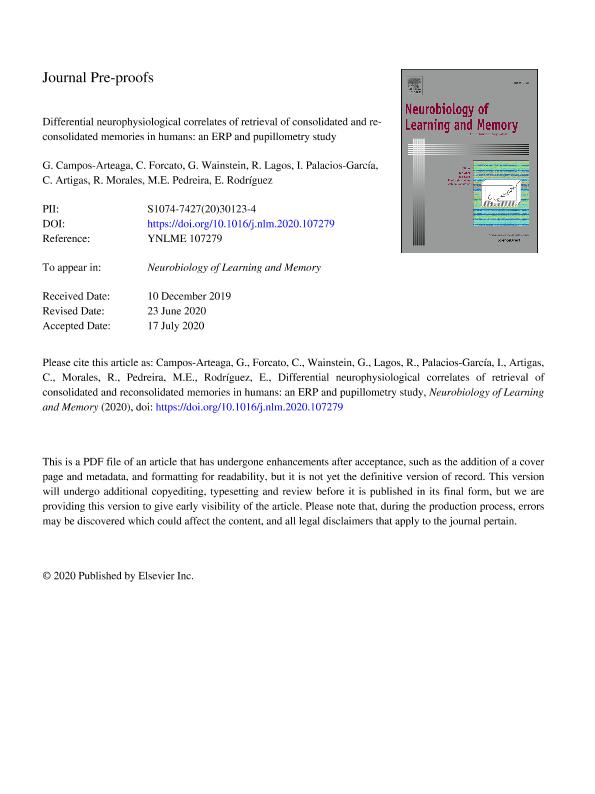Mostrar el registro sencillo del ítem
dc.contributor.author
Campos Arteaga, G.
dc.contributor.author
Forcato, Cecilia

dc.contributor.author
Wainstein, G.
dc.contributor.author
Lagos, R.
dc.contributor.author
Palacios García, I.
dc.contributor.author
Artigas, C.
dc.contributor.author
Morales, R.
dc.contributor.author
Pedreira, Maria Eugenia

dc.contributor.author
Rodríguez, E.
dc.date.available
2022-03-23T00:57:08Z
dc.date.issued
2020-10
dc.identifier.citation
Campos Arteaga, G.; Forcato, Cecilia; Wainstein, G.; Lagos, R.; Palacios García, I.; et al.; Differential neurophysiological correlates of retrieval of consolidated and reconsolidated memories in humans: An ERP and pupillometry study; Academic Press Inc Elsevier Science; Neurobiology of Learning and Memory; 174; 107279; 10-2020; 1-14
dc.identifier.issn
1074-7427
dc.identifier.uri
http://hdl.handle.net/11336/153779
dc.description.abstract
Consolidated memories can return to a labile state if they are reactivated by unpredictable reminders. To persist, active memories must be re-stabilized through a process known as reconsolidation. Although there is consistent behavioral evidence about this process in humans, the retrieval process of reconsolidated memories remains poorly understood. In this context, one fundamental question is whether the same or different neurophysiological mechanisms are involved in retrieval of consolidated and reconsolidated memories. Because it has been demonstrated that the exposure to the reconsolidation process may restructure and strengthen memories, we hypothesized distinct neurophysiological patterns during retrieval of reconsolidated memories. In addition, we hypothesized that interfering with the reconsolidation process using a new learning can prevent these neurophysiological changes. To test it, consolidated, reconsolidated and declarative memories whose reconsolidation process was interfered (i.e., picture-word pairs) were evaluated in humans in an old/new associative recall task while the brain activity and the pupillary response were recorded using electroencephalography and eyetracking. Our results showed that retrieval of reconsolidated memories elicits specific patterns of brain activation, characterized by an earlier peak latency and a smaller magnitude of the left parietal ERP old/new effect compared to memories that were only consolidated or whose reconsolidation process was interfered by a new learning. Moreover, our results demonstrated that only retrieval of reconsolidated memories is associated with a late reversed mid-frontal effect in a 600–690 time window. Complementarily, memories that were reactivated showed an earlier peak latency of the pupil old/new effect compared to non-reactivated memories. These findings support the idea that reconsolidation has an important impact in how memories are retrieved in the future, showing that retrieval of reconsolidated memories is partially supported by specific brain mechanisms.
dc.format
application/pdf
dc.language.iso
eng
dc.publisher
Academic Press Inc Elsevier Science

dc.rights
info:eu-repo/semantics/openAccess
dc.rights.uri
https://creativecommons.org/licenses/by-nc-sa/2.5/ar/
dc.subject
RECONSOLIDATION
dc.subject
DECLARATIVE MEMORY
dc.subject
ERPS
dc.subject
PUPILLOMETRY
dc.subject.classification
Otras Ciencias Naturales y Exactas

dc.subject.classification
Otras Ciencias Naturales y Exactas

dc.subject.classification
CIENCIAS NATURALES Y EXACTAS

dc.title
Differential neurophysiological correlates of retrieval of consolidated and reconsolidated memories in humans: An ERP and pupillometry study
dc.type
info:eu-repo/semantics/article
dc.type
info:ar-repo/semantics/artículo
dc.type
info:eu-repo/semantics/publishedVersion
dc.date.updated
2022-03-14T21:10:01Z
dc.identifier.eissn
1095-9564
dc.journal.volume
174
dc.journal.number
107279
dc.journal.pagination
1-14
dc.journal.pais
Estados Unidos

dc.description.fil
Fil: Campos Arteaga, G.. Pontificia Universidad Católica de Chile; Chile
dc.description.fil
Fil: Forcato, Cecilia. Instituto Tecnológico de Buenos Aires; Argentina. Consejo Nacional de Investigaciones Científicas y Técnicas; Argentina
dc.description.fil
Fil: Wainstein, G.. Pontificia Universidad Católica de Chile; Chile. The University of Sydney,; Australia
dc.description.fil
Fil: Lagos, R.. Universidad de Chile; Chile
dc.description.fil
Fil: Palacios García, I.. Pontificia Universidad Católica de Chile; Chile. Universidad Diego Portales; Chile
dc.description.fil
Fil: Artigas, C.. Pontificia Universidad Católica de Chile; Chile
dc.description.fil
Fil: Morales, R.. Pontificia Universidad Católica de Chile; Chile
dc.description.fil
Fil: Pedreira, Maria Eugenia. Consejo Nacional de Investigaciones Científicas y Técnicas. Oficina de Coordinación Administrativa Ciudad Universitaria. Instituto de Fisiología, Biología Molecular y Neurociencias. Universidad de Buenos Aires. Facultad de Ciencias Exactas y Naturales. Instituto de Fisiología, Biología Molecular y Neurociencias; Argentina
dc.description.fil
Fil: Rodríguez, E.. Pontificia Universidad Católica de Chile; Chile
dc.journal.title
Neurobiology of Learning and Memory

dc.relation.alternativeid
info:eu-repo/semantics/altIdentifier/url/https://www.sciencedirect.com/science/article/pii/S1074742720301234
dc.relation.alternativeid
info:eu-repo/semantics/altIdentifier/doi/http://dx.doi.org/10.1016/j.nlm.2020.107279
Archivos asociados
